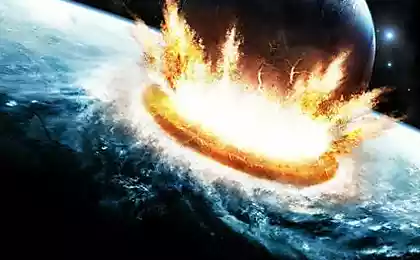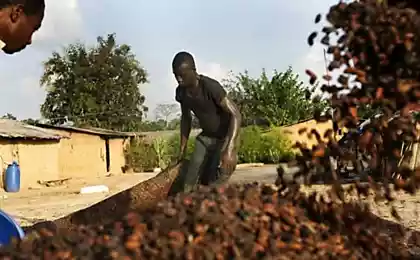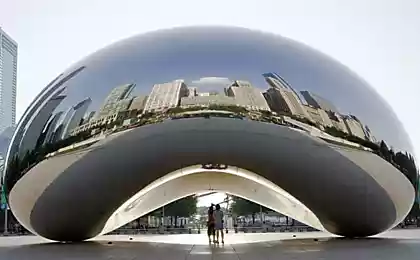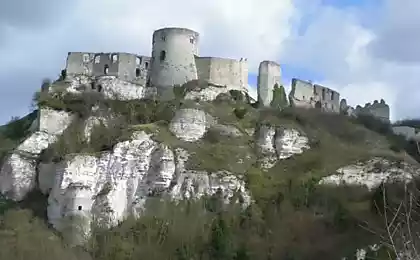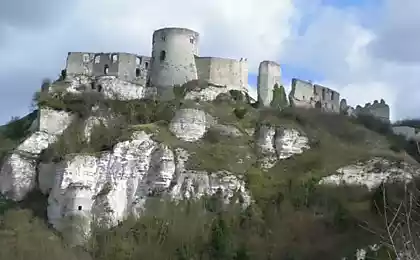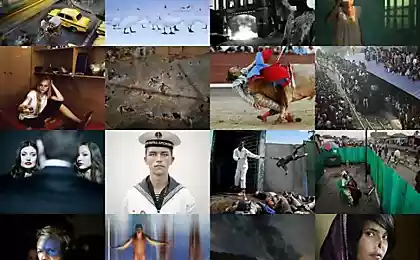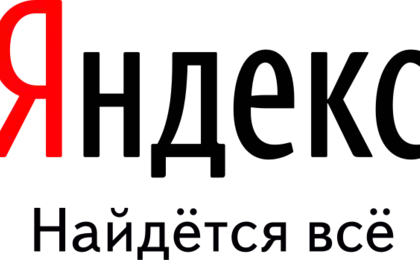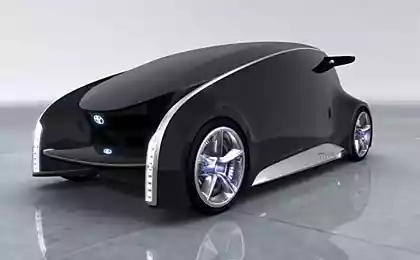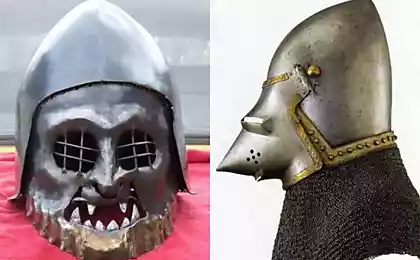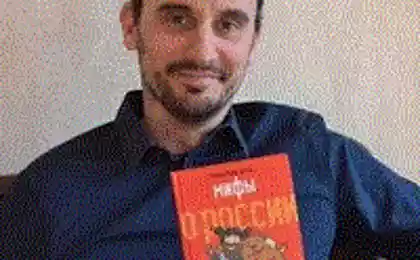8494
The development of armor in Western Europe (VII - end of XV centuries.)
In this article, in the most general terms deals with the process of development of armor in Western Europe in the Middle Ages (VII - end XV cc.) And at the beginning of early modern times (beginning of the XVI century.). The material has a large number of illustrations for a better understanding of the topic. Most of the text is translated from English.
27 photos
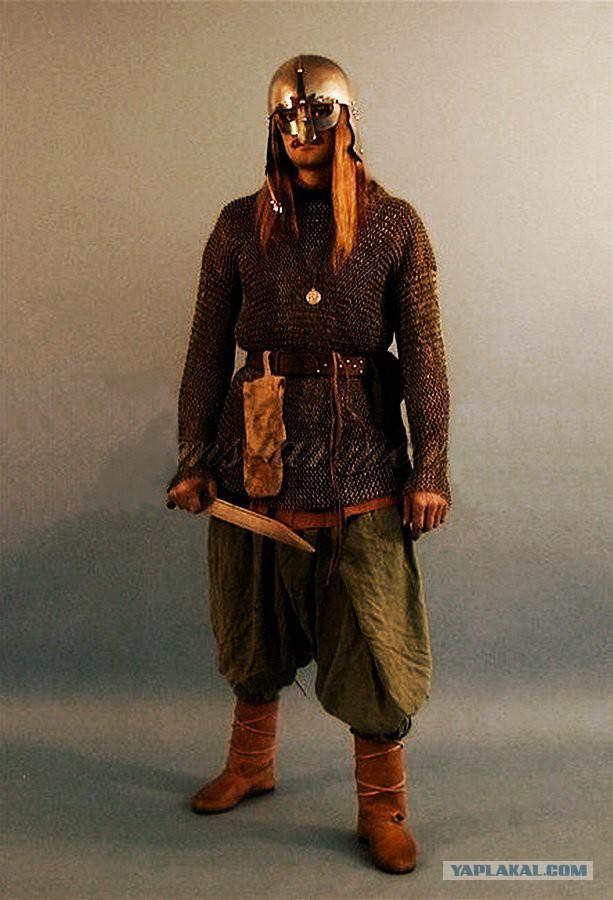
Mid VII - IX centuries. Viking Vendel helmet. Used mainly in Northern Europe by the Normans, Germans, et al., Although often found in other parts of Europe. Very often has a half-mask covering the upper part of the face. Later evolved into a Norman helmet. Armor: short chain mail without Chain Hood, worn over a shirt. Shield round, flat, of medium size, with a large shield boss - a metal plate-convex hemisphere in the center, typical of Northern Europe this period. On billboards used gyuzh - strap for wearing a shield during a hike in the neck or shoulder. Naturally, the horned helmet at the time did not exist.

X - the beginning of the XIII century. Knight Norman helmet with Rondache. Open Nasal helmet conical or ovoid. Typically,
Front fastens nanosnik - metal nasal plate. Was widely distributed throughout Europe, both in western and eastern parts. Armor: a long chain mail to the knees, with sleeves full or part-time (up to elbow) length, with Coif - Chain Hood, representing the individual or a single entity with a coat of mail. In the latter case, the chain mail called "houberk." Front and rear sections in chain mail at the hem for easy movement (and more comfortable to sit in the saddle). Since the end of IX - beginning of X century. under the chain mail knights start wearing gambeson - long poddospeshnuyu clothes, stuffed with wool or hemp to such a state to absorb shocks by mail. In addition to the gambeson perfectly stuck arrows. Often used as a separate armor poorer compared with the Knights Marines, especially archers.

Often worn to protect feet highway - Mail stockings. With the X century. appears Rondache - large Western European knights shield the early Middle Ages, and often grunts - for example, the Anglo-Saxon Housecarl. Could take various forms, usually round or oval, curved and with a shield boss. The Knights Rondache almost always has a pointed shape the bottom - it covered the knights left leg. Produced in different versions in Europe in the X-XIII centuries.

Charge of the Knights in Nasal helmet. It looked so Crusaders captured Jerusalem in 1099

XII - early XIII centuries. Knight-piece in Norman helmet in surcoat. Nanosnik not already attached, and forged together with the helmet. Atop began wearing chainmail surcoat - a long and spacious cape different styles, with sleeves of different lengths and without, plain or patterned. Fashion has gone to the First Crusade, when the knights saw like a cloak from the Arabs. Like chainmail, had the front and rear sections at the hem. Functions cloak: overheating protection of mail in the sun, its protection from rain and dirt. Wealthy knights in order to improve protection could wear a double coat of mail, and in addition to fasten nanosniku half mask covering the upper part of the face.

Archer with a longbow. XI-XIV centuries.
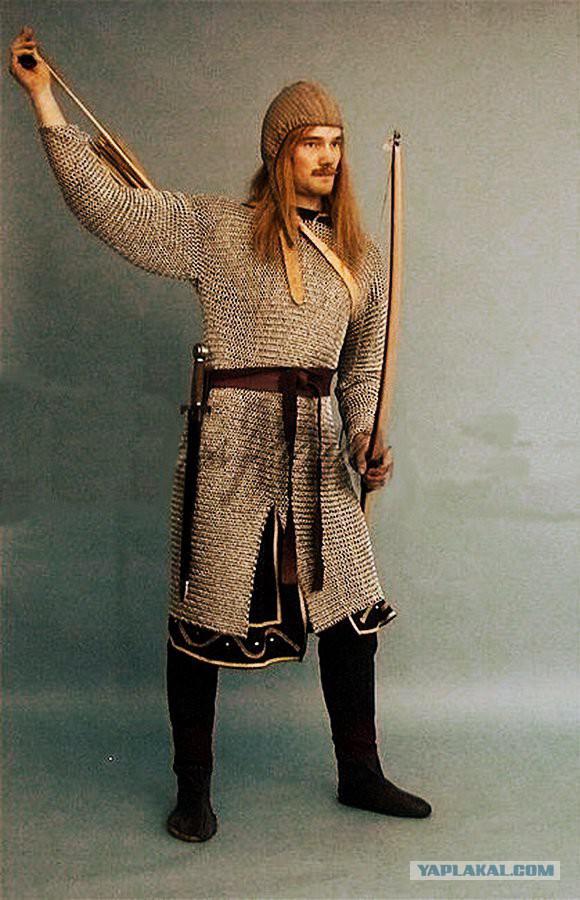
End of the XII - XIII centuries. Knight closed pothelme. Early pothelmy were without face protection, could have nanosnik. Gradually defense prevailed until the helmet did not completely cover the face. Late pothelm - Europe's first helmet with visor (visor), a full-face. By the middle of the XIII century. evolved in Great helm - The pot or large helmet. Armor does not significantly change, still the same long chain mail hood. Appear muffery - Mail Gauntlets, pripletennye to houberku. But the wide distribution they received, knights were popular leather gloves.

Surcoat several increases in volume in the largest variant becoming Tabard - clothing, worn over armor, sleeveless, which showed the coat of arms of the owner.
King of England Edward I Longshanks (1239-1307 gg.) In an open and pothelme Tabard
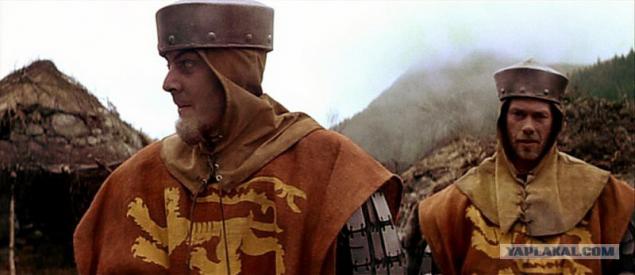
The first half of the XIII century. Knight in Great helm with Target, Allier. Great helm - knight's helmet, which appeared in the late XII - early XIII century. Used exclusively by knights. The shape may be cylindrical, barrel-shaped or frustoconical fully protect the head. Great helm worn over the Chain Hood, under which, in turn, puts a felt liner to soften the blows to the head. Armor: a long chain mail, sometimes double, with a hood. In the XIII century. appears as a mass phenomenon, Mail-Brigantine armor that provides greater protection than just a coat of mail.

Brigantine - armor of metal plates naklёpannyh on cloth or quilted linen basis. Early Chain-Brigantine armor consisted worn over chainmail bibs or vests. Shields knights, in connection with the improvement to the middle of the XIII century. protective qualities of the armor and the advent of fully enclosed helmets significantly reduced in size, becoming Target, Allier. Target, Allier - kind of a shield in the shape of a wedge, without the shield boss, actually cropped top version guttate Rondache. Now knights no longer hide behind the face shields.
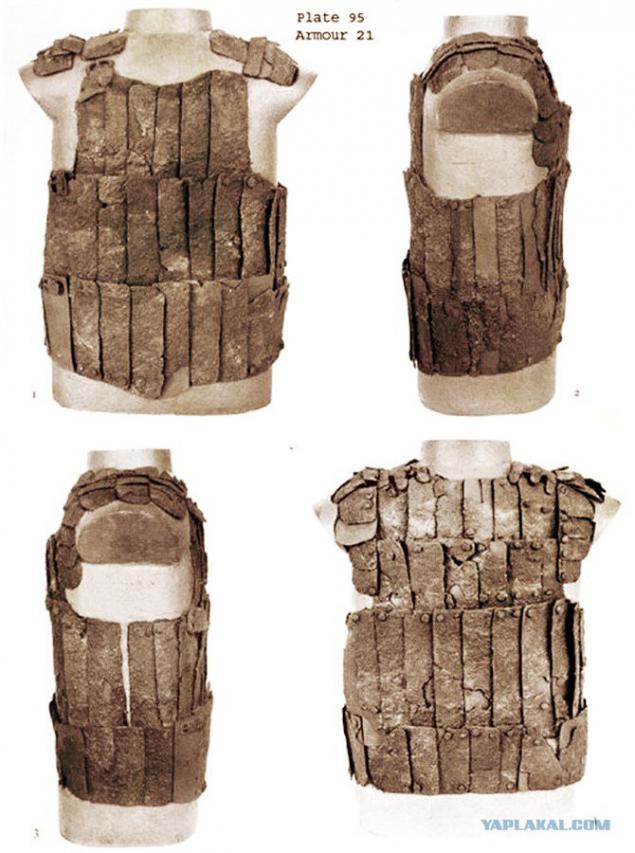
The second half of the XIII - XIV centuries beginning. Knight in Great helm with a surcoat aylettami. A specific feature of Great helm is a very bad review, so they were used, as a rule, only the collision of a spear. For melee Great helm fits poorly because of the disgusting visibility. So knights, if it came to blows, dumped him. A road to the helmet was not lost during the battle, it was fixed to the rear of the neck chain or a special belt. After that, the knight remained Chain Hood with felt balaclavas underneath that was a weak defense against powerful blows heavy medieval sword.
More Great helm to head no crepes and rested on his shoulders. Naturally, the poor knights did without Cervelliere. Ayletty - Shoulder rectangular plates, similar to the shoulder straps covered with heraldic symbols. Used in Western Europe in the XIII - XIV centuries early. as primitive Shoulders. There is a hypothesis that came from aylettov chase.

So very soon the knights began to wear a helmet Great helm spherical - Cervelliere or hirnhaube, is a small hemispherical helmet, tight-fitting head like a helmet. Cervelliere no element has no face protection, only very rare Cervelliere have nanosniki. In this case, to denser Great helm sat on his head and is not shifted to the side, under it was put on top Cervelliere felt roller.
Cervelliere. XIV century.
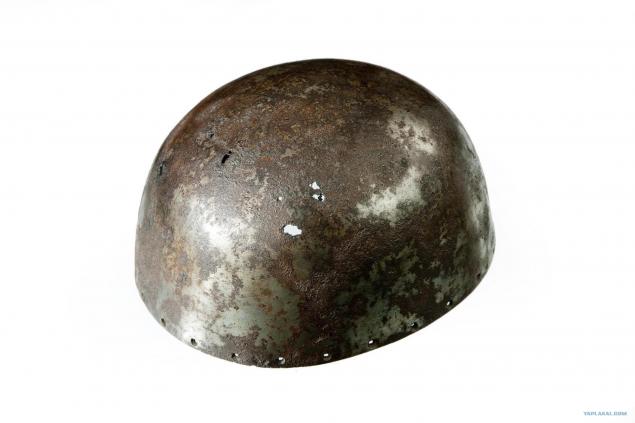
Since the end of XIII - XIV centuries beginning. There was widespread tournament helmet-mounted jewelry - various heraldic figures (Regalia) that were made of leather or wood and are attached to the helmet. A lot of Germans widely different kind of horn. Ultimately Great helm completely out of use in the war, remained purely tournament helmet collision of spear.
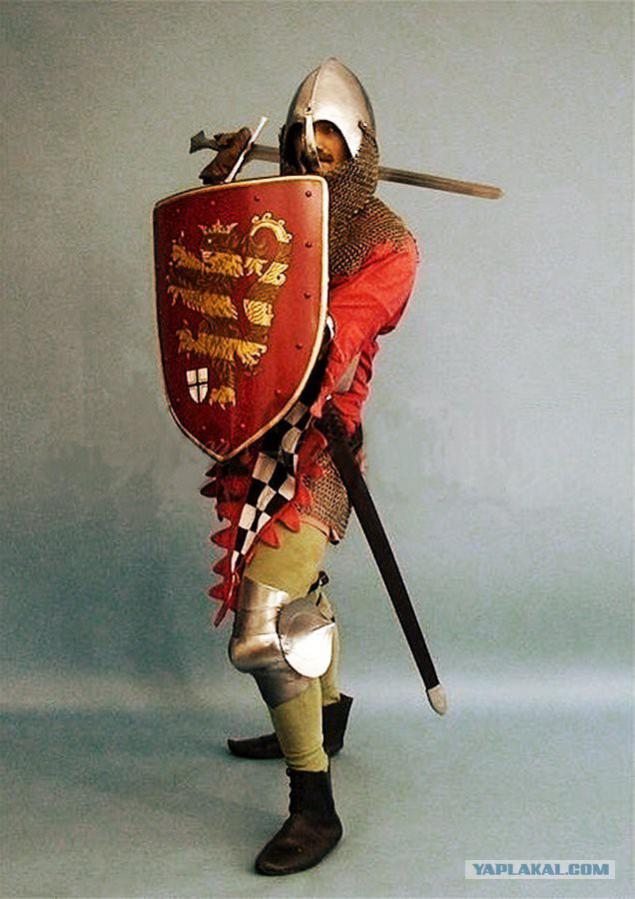
The first half of XIV - early XV century. Knight in bascinet with aventaylom. In the first half of the XIV century. replaced the Great helm comes bascinet - spheroconical helmet with a pointed top, to which the drag aventayl - Chain cape, helmet framing on the bottom edge and closing the neck, shoulders, neck and sides of the head. Bascinet worn not only knights, but the Marines.

There are many varieties bascinets like shape of the helmet and the visor-type fastening various types, with and without nanosnikom. The simplest, and therefore the common visors for bascinet were relatively flat klapvizory - actually face mask. At the same time, there is a kind of bascinet with visor Hounskull - the ugliest helmet in European history, yet very common. Obviously, the security at the time was more important than appearance.
Bascinet with visor Hounskull. The end of the XIV century.

Later, from the beginning of the XV century. Bascinets steel plate provided with the protection of the neck instead of Chain aventayla. Armor at this time also develop in ways to strengthen protection, are still used with chainmail Brigantine gain, but with larger plates, it is better to take a punch. Began to appear some elements of plate items: first plastrons or Plackart, cover your belly, and breastplates, and then Plate Breastplate. Although due to its high cost Plate cuirass in the early XV century. were available to few knights. Also appear in large numbers: Bracers - part armor, protecting hands from the elbow to the wrist, and elbow pads developed, Greaves and knee pads. In the second half of the XIV century. replaced gambeson comes aketon - quilted jacket with sleeves poddospeshnaya similar to gambeson, but not so thick and long. Are made from several layers of fabric, or rhombic prostёgivalas vertical seams. Additionally, nothing has jammed. The sleeves were made separately to the shoulders and prishnurovyvalis aketona. With the development of plate armor that did not require so thick poddospeshnikov like chain mail, in the first half of the XV century. aketon gradually supplanted knights gambeson, although among the infantry, he remained popular until the end of the XV century., primarily because of its cheapness. In addition, the Knights could use richer doublet or purpuen - essentially the same aketon, but with enhanced protection from chain armor inserts.
This period, end of XIV - early XV cc., Is characterized by a great variety of combinations of armor: Chain, Chain-Brigantine, composite of chain mail or brigantine basics with Chestpiece, back plate or cuirass, and even bus-Brigantine armor, not to mention all sorts of bracers pads, elbow pads, knee pads and greaves, as well as open and closed helmets with a variety of visors. Shields of small size (Target, Allier) Knights still used.
The looting of the city. France. Thumbnail beginning of the XV century.

By the middle of the XIV century., Following the spread throughout Western Europe, the new fashion for shortening outerwear surcot too much shortened and becomes zhupon or Tabari performs the same function. Bascinet gradually evolved into a grand bascinet - closed helmet, rounded, with a visor and neck protection hemispherical shape with numerous holes. Out of use at the end of the XV century.

ervaya half and the end of the XV century. Knight in Salado. All further development of the armor is on ways to strengthen protection. That the XV century. can be called the century of plate items when they become somewhat more affordable and as a result, appear en masse at the Knights and to a lesser extent in the infantry.
Crossbowman with Pavese. Mid-second half of the XV century.
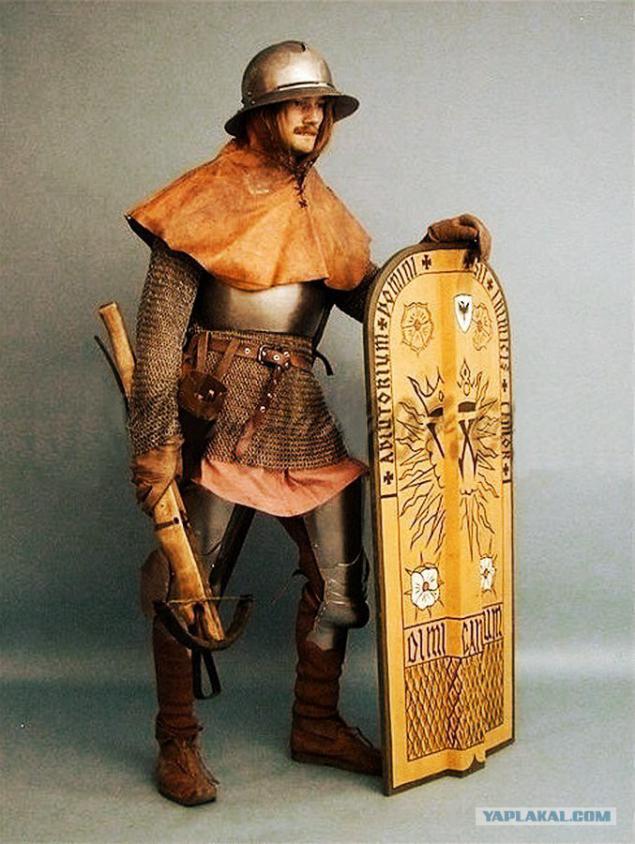
With the development of blacksmithing design plate items increasingly improved, and armor themselves varies according dospeshnoy fashion, but West European Plate armor always has the best protective qualities. By the middle of the XV century. hands and feet most of the knights already fully protects Plate Armor, torso - Plate cuirass with a skirt, fastened to the bottom edge of the cuirass. Also in droves instead of leather appear Plate Gloves. In place aventaylu comes Gorge, - Plate protection of the neck and upper chest. Could be combined with the helmet as well as with a cuirass.
In the second half of the XV century. appears Armagh - a new type of knight's helmet XV-XVI centuries., with a double visor and neck protection. The design of the helmet has a rigid spherical dome and rear of the movable face and neck protection for the front and sides, on top of which falls strapped atop the visor. With this design Armagh gives excellent protection as a collision of spear and melee. Armagh - the highest stage of evolution of helmets in Europe.
Armet. Middle of the XVI century.

But it was very expensive and therefore available only to the wealthy knights. Most of the Knights in the second half of XV century. Salado was of sorts - the type of helmet, elongated neck and closing the rear. Widely used in Salado, along with Chapelle - the simplest helmets, and in the infantry.
Infantryman in Chapelle cuirass. The first half of the XV century.
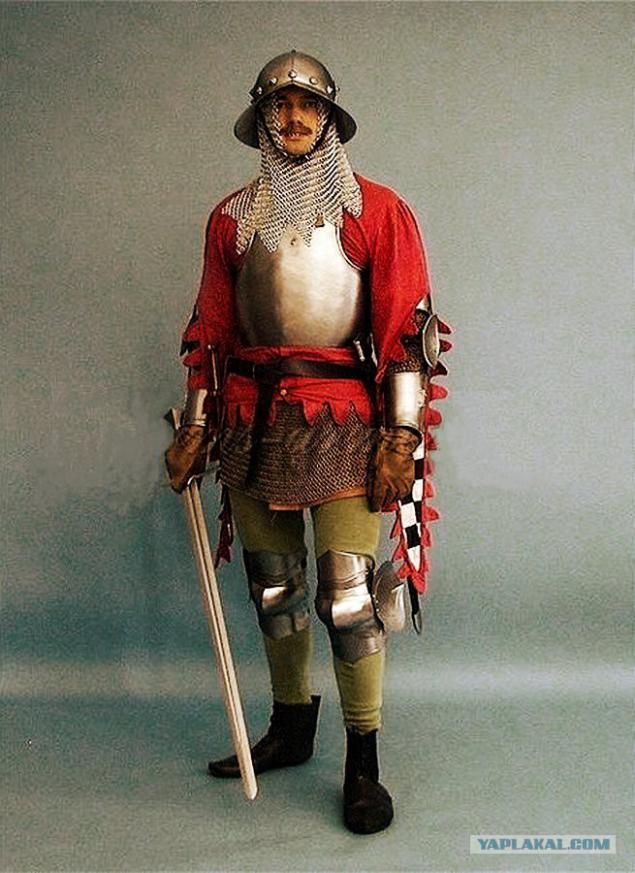
For knights specially forged deep Salad with full protection of persons (field front and sides forged steel vertical and actually part of the dome) and the neck, which was supplemented Bevor helmet - for the protection of the collarbone, neck and lower face.
Knight in Chapelle Bevor. Middle - second half of the XV century.

In the XV century. there is a gradual abandonment of shields as such (because of the emergence of mass plate items). Shields in the XV century. turned into bucklers - small round Bucklers necessarily steel and with a shield boss. There are as a replacement for hiking Target, Allier chivalrous combat, which used to parry blows and blows umbon or edge on the face of the enemy.
Buckler. Diameter 39, 5 cm. In the early XVI.
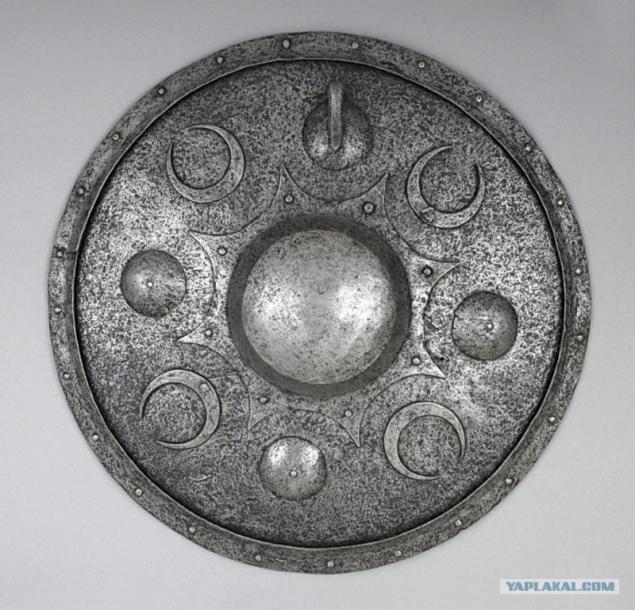
End of the XV - XVI centuries. Knight in full plate armor. XVI century. Historians refer not to the Middle Ages and the early modern times. Therefore, the full plate armor of item - a phenomenon largely of modern times, not the Middle Ages, although it appeared in the first half of the XV century. in Milan, famous as a center of production of the best armor in Europe. Besides the full plate armor of item always was very expensive, and therefore was available only to the most affluent part of chivalry. Full plate armor covering the whole body with steel plates, and closed head helmet - the culmination of the development of European armor. Appear poldrony - Plate Shoulders, protecting shoulder, upper arm, shoulder blade steel plates due to its relatively large size. Also to enhance the protection to steel plate skirt fastened tassety - Tassets.
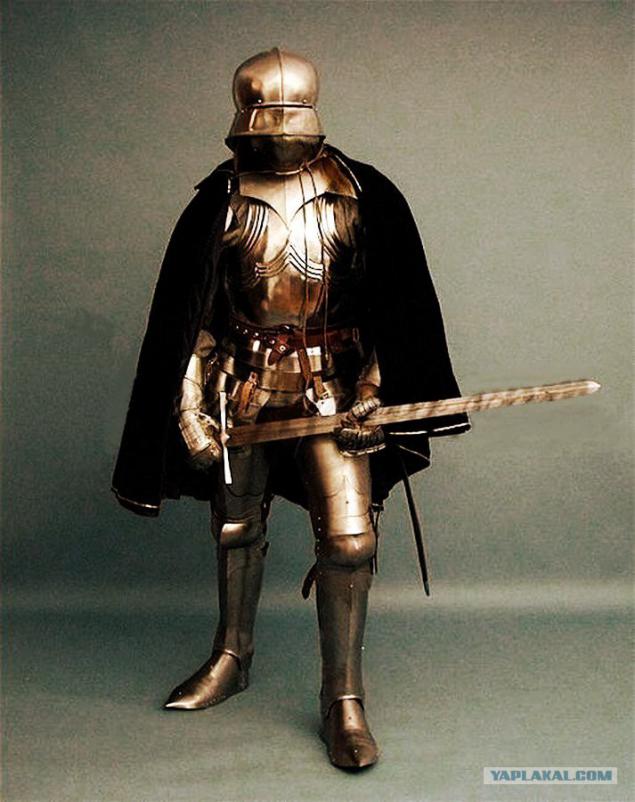
In the same period there is a bard - Plate horse armor. Consist of the following elements: shanfren - protection muzzle kritnet - protection of the neck, peytral - protection chest krupper - protection of croup and flanshard - protection sides.
Full armor for a knight and horse. Nuremberg. Weight (total) armor rider - 26, 39 kg. Weight (total) horse armor - 28, 47 kg. 1532-1536 gg.

At the end of the XV - beginning of XVI century. place two opposite processes: if armor cavalry increasingly intensified, the infantry, on the contrary, more laid bare. During this period, there are famous mercenaries - German mercenaries who served during the reign of Maximilian I (1486-1519 gg.), And his grandson Charles V (1519-1556 gg.), Leaving himself from the entire defense at best only a cuirass with tassetami. < br />
topwar.ru/53097-razvitie-dospehov-v...noy-evrope.html
Landsknecht. End XV - first half of the XVI century.
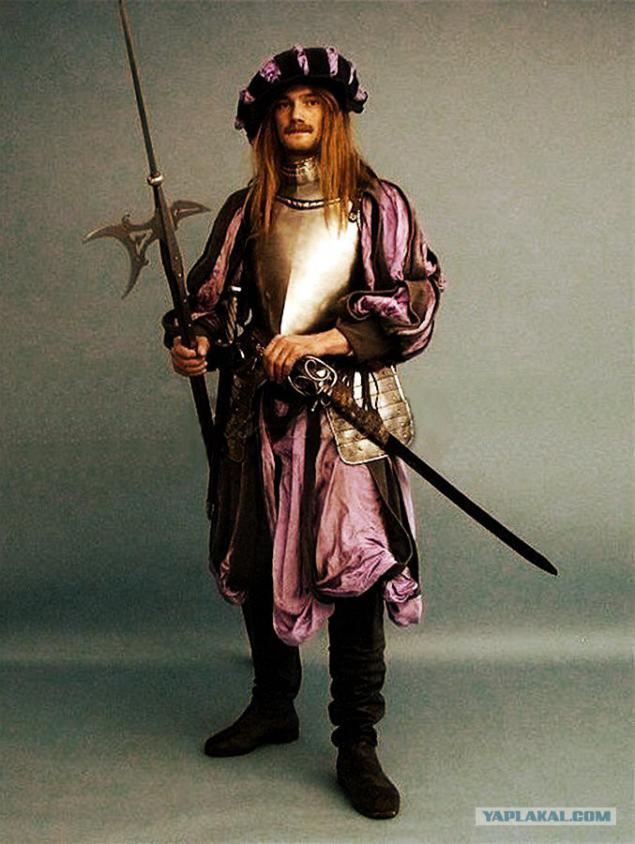
27 photos

Mid VII - IX centuries. Viking Vendel helmet. Used mainly in Northern Europe by the Normans, Germans, et al., Although often found in other parts of Europe. Very often has a half-mask covering the upper part of the face. Later evolved into a Norman helmet. Armor: short chain mail without Chain Hood, worn over a shirt. Shield round, flat, of medium size, with a large shield boss - a metal plate-convex hemisphere in the center, typical of Northern Europe this period. On billboards used gyuzh - strap for wearing a shield during a hike in the neck or shoulder. Naturally, the horned helmet at the time did not exist.

X - the beginning of the XIII century. Knight Norman helmet with Rondache. Open Nasal helmet conical or ovoid. Typically,
Front fastens nanosnik - metal nasal plate. Was widely distributed throughout Europe, both in western and eastern parts. Armor: a long chain mail to the knees, with sleeves full or part-time (up to elbow) length, with Coif - Chain Hood, representing the individual or a single entity with a coat of mail. In the latter case, the chain mail called "houberk." Front and rear sections in chain mail at the hem for easy movement (and more comfortable to sit in the saddle). Since the end of IX - beginning of X century. under the chain mail knights start wearing gambeson - long poddospeshnuyu clothes, stuffed with wool or hemp to such a state to absorb shocks by mail. In addition to the gambeson perfectly stuck arrows. Often used as a separate armor poorer compared with the Knights Marines, especially archers.

Often worn to protect feet highway - Mail stockings. With the X century. appears Rondache - large Western European knights shield the early Middle Ages, and often grunts - for example, the Anglo-Saxon Housecarl. Could take various forms, usually round or oval, curved and with a shield boss. The Knights Rondache almost always has a pointed shape the bottom - it covered the knights left leg. Produced in different versions in Europe in the X-XIII centuries.

Charge of the Knights in Nasal helmet. It looked so Crusaders captured Jerusalem in 1099

XII - early XIII centuries. Knight-piece in Norman helmet in surcoat. Nanosnik not already attached, and forged together with the helmet. Atop began wearing chainmail surcoat - a long and spacious cape different styles, with sleeves of different lengths and without, plain or patterned. Fashion has gone to the First Crusade, when the knights saw like a cloak from the Arabs. Like chainmail, had the front and rear sections at the hem. Functions cloak: overheating protection of mail in the sun, its protection from rain and dirt. Wealthy knights in order to improve protection could wear a double coat of mail, and in addition to fasten nanosniku half mask covering the upper part of the face.

Archer with a longbow. XI-XIV centuries.

End of the XII - XIII centuries. Knight closed pothelme. Early pothelmy were without face protection, could have nanosnik. Gradually defense prevailed until the helmet did not completely cover the face. Late pothelm - Europe's first helmet with visor (visor), a full-face. By the middle of the XIII century. evolved in Great helm - The pot or large helmet. Armor does not significantly change, still the same long chain mail hood. Appear muffery - Mail Gauntlets, pripletennye to houberku. But the wide distribution they received, knights were popular leather gloves.

Surcoat several increases in volume in the largest variant becoming Tabard - clothing, worn over armor, sleeveless, which showed the coat of arms of the owner.
King of England Edward I Longshanks (1239-1307 gg.) In an open and pothelme Tabard

The first half of the XIII century. Knight in Great helm with Target, Allier. Great helm - knight's helmet, which appeared in the late XII - early XIII century. Used exclusively by knights. The shape may be cylindrical, barrel-shaped or frustoconical fully protect the head. Great helm worn over the Chain Hood, under which, in turn, puts a felt liner to soften the blows to the head. Armor: a long chain mail, sometimes double, with a hood. In the XIII century. appears as a mass phenomenon, Mail-Brigantine armor that provides greater protection than just a coat of mail.

Brigantine - armor of metal plates naklёpannyh on cloth or quilted linen basis. Early Chain-Brigantine armor consisted worn over chainmail bibs or vests. Shields knights, in connection with the improvement to the middle of the XIII century. protective qualities of the armor and the advent of fully enclosed helmets significantly reduced in size, becoming Target, Allier. Target, Allier - kind of a shield in the shape of a wedge, without the shield boss, actually cropped top version guttate Rondache. Now knights no longer hide behind the face shields.

The second half of the XIII - XIV centuries beginning. Knight in Great helm with a surcoat aylettami. A specific feature of Great helm is a very bad review, so they were used, as a rule, only the collision of a spear. For melee Great helm fits poorly because of the disgusting visibility. So knights, if it came to blows, dumped him. A road to the helmet was not lost during the battle, it was fixed to the rear of the neck chain or a special belt. After that, the knight remained Chain Hood with felt balaclavas underneath that was a weak defense against powerful blows heavy medieval sword.
More Great helm to head no crepes and rested on his shoulders. Naturally, the poor knights did without Cervelliere. Ayletty - Shoulder rectangular plates, similar to the shoulder straps covered with heraldic symbols. Used in Western Europe in the XIII - XIV centuries early. as primitive Shoulders. There is a hypothesis that came from aylettov chase.

So very soon the knights began to wear a helmet Great helm spherical - Cervelliere or hirnhaube, is a small hemispherical helmet, tight-fitting head like a helmet. Cervelliere no element has no face protection, only very rare Cervelliere have nanosniki. In this case, to denser Great helm sat on his head and is not shifted to the side, under it was put on top Cervelliere felt roller.
Cervelliere. XIV century.

Since the end of XIII - XIV centuries beginning. There was widespread tournament helmet-mounted jewelry - various heraldic figures (Regalia) that were made of leather or wood and are attached to the helmet. A lot of Germans widely different kind of horn. Ultimately Great helm completely out of use in the war, remained purely tournament helmet collision of spear.

The first half of XIV - early XV century. Knight in bascinet with aventaylom. In the first half of the XIV century. replaced the Great helm comes bascinet - spheroconical helmet with a pointed top, to which the drag aventayl - Chain cape, helmet framing on the bottom edge and closing the neck, shoulders, neck and sides of the head. Bascinet worn not only knights, but the Marines.

There are many varieties bascinets like shape of the helmet and the visor-type fastening various types, with and without nanosnikom. The simplest, and therefore the common visors for bascinet were relatively flat klapvizory - actually face mask. At the same time, there is a kind of bascinet with visor Hounskull - the ugliest helmet in European history, yet very common. Obviously, the security at the time was more important than appearance.
Bascinet with visor Hounskull. The end of the XIV century.

Later, from the beginning of the XV century. Bascinets steel plate provided with the protection of the neck instead of Chain aventayla. Armor at this time also develop in ways to strengthen protection, are still used with chainmail Brigantine gain, but with larger plates, it is better to take a punch. Began to appear some elements of plate items: first plastrons or Plackart, cover your belly, and breastplates, and then Plate Breastplate. Although due to its high cost Plate cuirass in the early XV century. were available to few knights. Also appear in large numbers: Bracers - part armor, protecting hands from the elbow to the wrist, and elbow pads developed, Greaves and knee pads. In the second half of the XIV century. replaced gambeson comes aketon - quilted jacket with sleeves poddospeshnaya similar to gambeson, but not so thick and long. Are made from several layers of fabric, or rhombic prostёgivalas vertical seams. Additionally, nothing has jammed. The sleeves were made separately to the shoulders and prishnurovyvalis aketona. With the development of plate armor that did not require so thick poddospeshnikov like chain mail, in the first half of the XV century. aketon gradually supplanted knights gambeson, although among the infantry, he remained popular until the end of the XV century., primarily because of its cheapness. In addition, the Knights could use richer doublet or purpuen - essentially the same aketon, but with enhanced protection from chain armor inserts.
This period, end of XIV - early XV cc., Is characterized by a great variety of combinations of armor: Chain, Chain-Brigantine, composite of chain mail or brigantine basics with Chestpiece, back plate or cuirass, and even bus-Brigantine armor, not to mention all sorts of bracers pads, elbow pads, knee pads and greaves, as well as open and closed helmets with a variety of visors. Shields of small size (Target, Allier) Knights still used.
The looting of the city. France. Thumbnail beginning of the XV century.

By the middle of the XIV century., Following the spread throughout Western Europe, the new fashion for shortening outerwear surcot too much shortened and becomes zhupon or Tabari performs the same function. Bascinet gradually evolved into a grand bascinet - closed helmet, rounded, with a visor and neck protection hemispherical shape with numerous holes. Out of use at the end of the XV century.

ervaya half and the end of the XV century. Knight in Salado. All further development of the armor is on ways to strengthen protection. That the XV century. can be called the century of plate items when they become somewhat more affordable and as a result, appear en masse at the Knights and to a lesser extent in the infantry.
Crossbowman with Pavese. Mid-second half of the XV century.

With the development of blacksmithing design plate items increasingly improved, and armor themselves varies according dospeshnoy fashion, but West European Plate armor always has the best protective qualities. By the middle of the XV century. hands and feet most of the knights already fully protects Plate Armor, torso - Plate cuirass with a skirt, fastened to the bottom edge of the cuirass. Also in droves instead of leather appear Plate Gloves. In place aventaylu comes Gorge, - Plate protection of the neck and upper chest. Could be combined with the helmet as well as with a cuirass.
In the second half of the XV century. appears Armagh - a new type of knight's helmet XV-XVI centuries., with a double visor and neck protection. The design of the helmet has a rigid spherical dome and rear of the movable face and neck protection for the front and sides, on top of which falls strapped atop the visor. With this design Armagh gives excellent protection as a collision of spear and melee. Armagh - the highest stage of evolution of helmets in Europe.
Armet. Middle of the XVI century.

But it was very expensive and therefore available only to the wealthy knights. Most of the Knights in the second half of XV century. Salado was of sorts - the type of helmet, elongated neck and closing the rear. Widely used in Salado, along with Chapelle - the simplest helmets, and in the infantry.
Infantryman in Chapelle cuirass. The first half of the XV century.

For knights specially forged deep Salad with full protection of persons (field front and sides forged steel vertical and actually part of the dome) and the neck, which was supplemented Bevor helmet - for the protection of the collarbone, neck and lower face.
Knight in Chapelle Bevor. Middle - second half of the XV century.

In the XV century. there is a gradual abandonment of shields as such (because of the emergence of mass plate items). Shields in the XV century. turned into bucklers - small round Bucklers necessarily steel and with a shield boss. There are as a replacement for hiking Target, Allier chivalrous combat, which used to parry blows and blows umbon or edge on the face of the enemy.
Buckler. Diameter 39, 5 cm. In the early XVI.

End of the XV - XVI centuries. Knight in full plate armor. XVI century. Historians refer not to the Middle Ages and the early modern times. Therefore, the full plate armor of item - a phenomenon largely of modern times, not the Middle Ages, although it appeared in the first half of the XV century. in Milan, famous as a center of production of the best armor in Europe. Besides the full plate armor of item always was very expensive, and therefore was available only to the most affluent part of chivalry. Full plate armor covering the whole body with steel plates, and closed head helmet - the culmination of the development of European armor. Appear poldrony - Plate Shoulders, protecting shoulder, upper arm, shoulder blade steel plates due to its relatively large size. Also to enhance the protection to steel plate skirt fastened tassety - Tassets.

In the same period there is a bard - Plate horse armor. Consist of the following elements: shanfren - protection muzzle kritnet - protection of the neck, peytral - protection chest krupper - protection of croup and flanshard - protection sides.
Full armor for a knight and horse. Nuremberg. Weight (total) armor rider - 26, 39 kg. Weight (total) horse armor - 28, 47 kg. 1532-1536 gg.

At the end of the XV - beginning of XVI century. place two opposite processes: if armor cavalry increasingly intensified, the infantry, on the contrary, more laid bare. During this period, there are famous mercenaries - German mercenaries who served during the reign of Maximilian I (1486-1519 gg.), And his grandson Charles V (1519-1556 gg.), Leaving himself from the entire defense at best only a cuirass with tassetami. < br />
topwar.ru/53097-razvitie-dospehov-v...noy-evrope.html
Landsknecht. End XV - first half of the XVI century.

